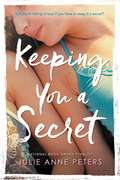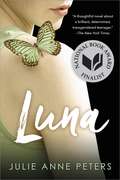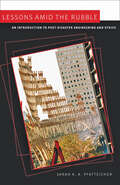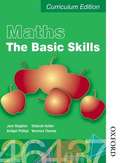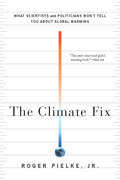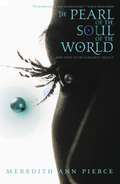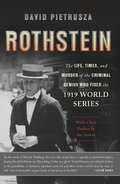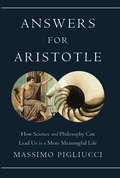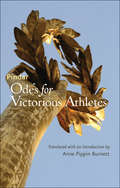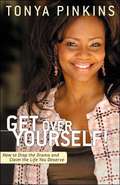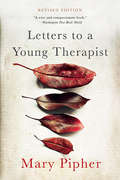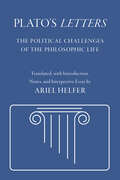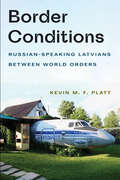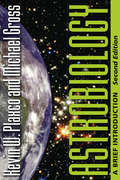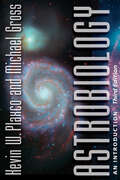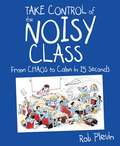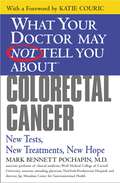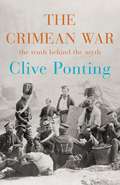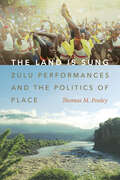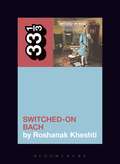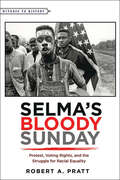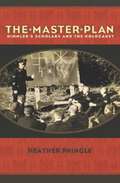- Table View
- List View
Keeping You a Secret
by Julie Anne PetersNational Book Award finalist Julie Anne Peters delivers a moving, classic love story with a coming out theme and a modern twist.With a steady boyfriend, the position of Student Council President, and a chance to go to an Ivy League college, high school life is just fine for Holland Jaeger. At least, it seems to be. But when Cece Goddard comes to school, everything changes. Cece and Holland have undeniable feelings for each other, but how will others react to their developing relationship?This moving love story between two girls is for fans of Nancy Garden's classic young adult coming out novel, Annie on My Mind. With her characteristic humor and breezy style, Peters has captured the compelling emotions of young love.
Luna (National Book Award Finalist)
by Julie Anne PetersA groundbreaking novel about a transgender teen, selected as a National Book Award Finalist! Regan's brother Liam can't stand the person he is during the day. Like the moon from whom Liam has chosen his female name, his true self, Luna, only reveals herself at night. In the secrecy of his basement bedroom, Liam transforms himself into the beautiful girl he longs to be, with help from his sister's clothes and makeup. Now, everything is about to change: Luna is preparing to emerge from her cocoon. But are Liam's family and friends ready to elcome Luna into their lives? Compelling and provocative, this is an unforgettable novel about a transgender teen's struggle for self-identity and acceptance.
Lessons amid the Rubble: An Introduction to Post-Disaster Engineering and Ethics (Johns Hopkins Introductory Studies in the History of Technology)
by Sarah K. PfatteicherThe aftermath of September 11, 2001, brought the subject of engineering-failure forensics to public attention as had no previous catastrophe. In keeping with the engineering profession's long tradition of building a positive future out of disasters, Lessons amid the Rubble uses the collapse of the World Trade Center towers to explore the nature and future of engineering education in the United States. Sarah K. A. Pfatteicher draws on historical and current practice in engineering design, construction, and curricula to discuss how engineers should conceive, organize, and execute a search for the reasons behind the failure of man-made structures. Her survey traces the analytical journey engineers take after a disaster and discusses the technical, social, and moral implications of their work. After providing an overview of the investigations into the collapse of the Twin Towers, Pfatteicher explores six related events to reveal deceptively simple lessons about the engineering enterprise, each of which embodies an ethical dilemma at the heart of the profession. In tying these themes together, Pfatteicher highlights issues of professionalism and professional identity infused in engineering education and encourages an explicit, direct conversation about their meaning.Sophisticated and engagingly written, this volume combines history, engineering, ethics, and philosophy to provoke a deep discussion about the symbolic meaning of buildings and other structures and the nature of engineering.
Maths the Basic Skills Curriculum Edition - Student Book (E3-L2) (Levels 1 and 2 and 3) (PDF)
by Bridget Phillips Debbie Holder June Haighton Veronica Nicky ThomasThe textbook targets the higher levels of the Adult Numeracy Curriculum, Entry Level 3, Level 1 and Level 2.
The Climate Fix: What Scientists and Politicians Won't Tell You About Global Warming
by Roger Pielke Jr.Why has the world been unable to address global warming? Science policy expert Roger Pielke, Jr., says it's not the fault of those who reject the Kyoto Protocol, but those who support it, and the magical thinking that the agreement represents. In The Climate Fix, Pielke offers a way to repair climate policy, shifting the debate away from meaningless targets and toward a revolution in how the world's economy is powered, while de-fanging the venomous politics surrounding the crisis. The debate on global warming has lost none of its power to polarize and provoke in a haze of partisan vitriol. The Climate Fix will bring something new to the discussions: a commonsense perspective and practical actions better than any offered so far.
The Pearl of the Soul of the World (The Darkangel Trilogy)
by Meredith Ann PierceThe spellbinding conclusion to the Darkangel Trilogy!Armed with a magical pearl imbued with all the sorcery and wisdom of the world, bestowed upon her by the Ancient known as Ravenna, Aeriel finally comes face-to-face with the White Witch and her vampire sons. Backed by her husband, his army of good, and a throng of magical steeds, she must unlock the power of the pearl to awaken her true destiny and save the world.
Rothstein: The Life, Times, and Murder of the Criminal Genius Who Fixed the 1919 World Series
by David PietruszaHistory remembers Arnold Rothstein as the man who fixed the 1919 World Series, an underworld genius. The real-life model for The Great Gatsby's Meyer Wolfsheim and Nathan Detroit from Guys and Dolls, Rothstein was much more-and less-than a fixer of baseball games. He was everything that made 1920s Manhattan roar. Featuring Jazz Age Broadway with its thugs, speakeasies, showgirls, political movers and shakers, and stars of the Golden Age of Sports, this is a biography of the man who dominated an age. Arnold Rothstein was a loan shark, pool shark, bookmaker, thief, fence of stolen property, political fixer, Wall Street swindler, labor racketeer, rumrunner, and mastermind of the modern drug trade. Among his monikers were "The Big Bankroll," "The Brain," and "The Man Uptown." This vivid account of Rothstein's life is also the story of con artists, crooked cops, politicians, gang lords, newsmen, speakeasy owners, gamblers and the like. Finally unraveling the mystery of Rothstein's November 1928 murder in a Times Square hotel room, David Pietrusza has cemented The Big Bankroll's place among the most influential and fascinating legendary American criminals. 16 pages of black-and-white photographs are featured.
Answers for Aristotle: How Science and Philosophy Can Lead Us to A More Meaningful Life
by Massimo PigliucciHow should we live? According to philosopher and biologist Massimo Pigliucci, the greatest guidance to this essential question lies in combining the wisdom of 24 centuries of philosophy with the latest research from 21st century science. In Answers for Aristotle, Pigliucci argues that the combination of science and philosophy first pioneered by Aristotle offers us the best possible tool for understanding the world and ourselves. As Aristotle knew, each mode of thought has the power to clarify the other: science provides facts, and philosophy helps us reflect on the values with which to assess them. But over the centuries, the two have become uncoupled, leaving us with questions—about morality, love, friendship, justice, and politics—that neither field could fully answer on its own. Pigliucci argues that only by rejoining each other can modern science and philosophy reach their full potential, while we harness them to help us reach ours. Pigliucci discusses such essential issues as how to tell right from wrong, the nature of love and friendship, and whether we can really ever know ourselves—all in service of helping us find our path to the best possible life. Combining the two most powerful intellectual traditions in history, Answers for Aristotle is a remarkable guide to discovering what really matters and why.
Odes for Victorious Athletes (Johns Hopkins New Translations from Antiquity)
by PindarYou've just won the gold medal, what are you going to do? In Ancient Greece, your patron could throw a feast in your honor and have a poet write a hymn of praise to you. The great poet Pindar composed many such odes for victorious athletes. Esteemed classicist Anne Pippin Burnett presents a fresh and exuberant translation of Pindar's victory songs.The typical Pindaric ode reflects three separate moments: the instant of success in contest, the victory night with its disorderly revels, and the actual banquet of family and friends where the commissioned poem is being offered as entertainment. In their essential effect, these songs transform a physical triumph, as experienced by one man, into a sense of elation shared by his peers—men who have gathered to dine and to drink.Athletic odes were presented by small bands of dancing singers, influencing the audience with music and dance as well as by words. These translations respect the form of the originals, keeping the stanzas that shaped repeating melodies and danced figures and using rhythms meant to suggest performers in motion.Pindar's songs were meant to entertain and exalt groups of drinking men. These translations revive the confident excitement of their original performances.
Get Over Yourself!: How to Drop the Drama and Claim the Life You Deserve
by Tonya PinkinsMost of us think we know what we want, and even why we can't get it. In her frank and inspiring book, Tonya Pinkins, star of television and Broadway, shows readers techniques and exercises that help them develop their own processes for obtaining their goals. This is tough love, Tonya style.In addition to being an actress and singer, Tonya has helped hundreds of people with her catalytic motivational seminars. She herself has seen the heights and the depths: from teen star to Tony Award winner to divorced mother on welfare to spiritual student to soaring success and unstoppable celebrity, delivering her magnificent solo performance at the 2004 Tony Awards show. In Get Over Yourself!, she takes the principles that helped her to succeed and puts them into a book that reaches out and grabs readers searching for a better way of life.
Letters to a Young Therapist: Stories Of Hope And Healing By The Author Of The Bestselling Surviving Ophelia (Letters To A Young... Ser.)
by Mary PipherFrom "one of America's best-known psychologists" (Chicago Tribune) and the bestselling author of Women Rowing North and Reviving Ophelia, an essential and inspiring book for therapists and anyone seeking to live a good lifeMary Pipher's groundbreaking investigation of America's "girl-poisoning culture," Reviving Ophelia, established its author as one of the nation's foremost authorities on family issues. In Letters to a Young Therapist, Pipher shares what she has learned in thirty years of clinical practice, helping warring families, alienated adolescents, and harried professionals restore peace and beauty to their lives. Through an exhilarating mix of storytelling and sharp-eyed observation, Pipher reveals her refreshingly inventive approach to therapy-fiercely optimistic, free of dogma or psychobabble, and laced with generous warmth and practical common sense. Whether she's recommending daily swims for a sluggish teenager, encouraging a timid husband to become bolder, or simply bearing witness to a bereaved parent's sorrow, Pipher's compassion and insight shine from every page. With a preface by the author addressing recent changes in therapy and the surprising challenges of the digital age, Letters to a Young Therapist is a powerfully engaging guide to living a healthy life.
Plato's "Letters": The Political Challenges of the Philosophic Life (Agora Editions)
by PlatoIn Plato's "Letters", Ariel Helfer provides to readers, for the first time, a highly literal translation of the Letters, complete with extensive notes on historical context and issues of manuscript transmission. His analysis presents a necessary perspective for readers who wish to study Plato's Letters as a work of Platonic philosophy. Centuries of debate over the provenance and significance of Plato's Letters have led to the common view that the Letters is a motley collection of jewels and scraps from within and without Plato's literary estate. In a series of original essays, Helfer describes how the Letters was written as a single work, composed with a unity of purpose and a coherent teaching, marked throughout by Plato's artfulness and insight and intended to occupy an important place in the Platonic corpus. Viewed in this light, the Letters is like an unusual epistolary novel, a manner of semifictional and semiautobiographical literary-philosophic experiment, in which Plato sought to provide his most demanding readers with guidance in thinking more deeply about the meaning of his own career as a philosopher, writer, and political advisor.Plato's "Letters" not only defends what Helfer calls the "literary unity thesis" by reviewing the scholarly history pertaining to the Platonic letters but also brings out the political philosophic lessons revealed in the Letters. As a result, Plato's "Letters" recovers and rehabilitates what has been until now a minority view concerning the Letters, according to which this misunderstood Platonic text will be of tremendous new importance for the study of Platonic political philosophy.
Border Conditions: Russian-Speaking Latvians between World Orders (NIU Series in Slavic, East European, and Eurasian Studies)
by Kevin M. PlattBorder Conditions combines history and memory studies with literary and cultural studies to examine lives at the limits of contemporary Europe: Russian speakers living in Latvia. Since the fall of the USSR in 1991, Latvia's Russian speakers have balanced between Russia and Europe as well as a socialist past, a capitalist and liberal present, and an illiberal regime rising in the Russian Federation. Kevin M. F. Platt describes how members of this population have defined themselves through art, literature, cultural institutions, film, and music—and how others have sought to define them. At the end of the Cold War, many anticipated that societies globally could agree on the meaning of past history and a just politics in the present. The view from the borders of Europe demonstrates the contradictions pertaining to terms like empire, state socialism, liberalism, and nation that have made it impossible to achieve a consensus. In refocusing the examination of state socialism's aftermath around questions of empire and postcolonialism, Border Conditions helps us understand the distinctions between Russian and Western worldviews driving military confrontation to this day.
Astrobiology: A Brief Introduction
by Kevin W. Plaxco Michael GrossInformed by new planetary discoveries and the findings from recent robotic missions to Mars, Jupiter, and Saturn, scientists are rapidly replacing centuries of speculation about potential extraterrestrial habitats with real knowledge about the possibility of life outside our own biosphere—if it exists, and where. This second edition of Kevin W. Plaxco and Michael Gross’s widely acclaimed text incorporates the latest research in astrobiology to bring readers the most comprehensive, up-to-date, and engaging introduction to the field available.Plaxco and Gross expand their examination of the origin of chemical elements, the developments that made the Universe habitable, and how life continues to be sustained. They discuss in great detail the formation of the first galaxies and stars, the diverse chemistry of the primordial planet, the origins of metabolism, the evolution of complex organisms, and the feedback regulation of Earth's climate. They also explore life in extreme habitats, potential extraterrestrial habitats, and the current status of the search for extraterrestrial life.Weaving together the relevant threads of astronomy, geology, chemistry, biophysics, and microbiology, this broadly accessible introductory text captures the excitement, controversy, and progress of the dynamic young field of astrobiology. New to this edition is a glossary of terms and an epilogue recapping the key unanswered questions, making Astrobiology an ideal primer for students and, indeed, for anyone curious about life and the Universe.
Astrobiology: An Introduction
by Kevin W. Plaxco Michael GrossExploring the potential for extraterrestrial life and the origins of our own planet, this comprehensive introduction to astrobiology is updated with the latest findings.Informed by the discoveries and analyses of extrasolar planets and the findings from recent robotic missions across the solar system, scientists are rapidly replacing centuries of speculation about potential extraterrestrial habitats with real knowledge about the possibility of life outside our own biosphere—if it exists, and, if so, where. Casting new light on the biggest questions there are—how did we get here, and who else might be out there?—this third edition of Kevin W. Plaxco and Michael Gross's widely acclaimed Astrobiology incorporates a decade's worth of new developments in space to bring readers the most comprehensive, up-to-date, and engaging introduction to the field available.Plaxco and Gross examine the factors that make our Universe habitable, from the origin of chemical elements and the formation of the first galaxies and stars to the birth and composition of the planets. They describe the latest thinking about the origins of life, explain the evolution of metabolism and the development of complex organisms. In order to assess the limits for life elsewhere, they also explore life in extreme habitats and reveal how it informs the search for potential extraterrestrial habitats—ones that might support extraterrestrial life. New and updated illustrations enhance the book throughout.Sharing fascinating findings from the comet mission Dawn, the visit of New Horizons to Pluto, and the work of the Deep Carbon Observatory, which has revealed an incredible underground biosphere within our own planet, Plaxco and Gross weave together cosmology, astrophysics, geology, biochemistry, biophysics, and microbiology. From neutron star mergers to the survival skills of tardigrades, this fascinating book is an ideal primer for students or anyone curious about life and the Universe.
Astrobiology: An Introduction
by Kevin W. Plaxco Michael GrossExploring the potential for extraterrestrial life and the origins of our own planet, this comprehensive introduction to astrobiology is updated with the latest findings.Informed by the discoveries and analyses of extrasolar planets and the findings from recent robotic missions across the solar system, scientists are rapidly replacing centuries of speculation about potential extraterrestrial habitats with real knowledge about the possibility of life outside our own biosphere—if it exists, and, if so, where. Casting new light on the biggest questions there are—how did we get here, and who else might be out there?—this third edition of Kevin W. Plaxco and Michael Gross's widely acclaimed Astrobiology incorporates a decade's worth of new developments in space to bring readers the most comprehensive, up-to-date, and engaging introduction to the field available.Plaxco and Gross examine the factors that make our Universe habitable, from the origin of chemical elements and the formation of the first galaxies and stars to the birth and composition of the planets. They describe the latest thinking about the origins of life, explain the evolution of metabolism and the development of complex organisms. In order to assess the limits for life elsewhere, they also explore life in extreme habitats and reveal how it informs the search for potential extraterrestrial habitats—ones that might support extraterrestrial life. New and updated illustrations enhance the book throughout.Sharing fascinating findings from the comet mission Dawn, the visit of New Horizons to Pluto, and the work of the Deep Carbon Observatory, which has revealed an incredible underground biosphere within our own planet, Plaxco and Gross weave together cosmology, astrophysics, geology, biochemistry, biophysics, and microbiology. From neutron star mergers to the survival skills of tardigrades, this fascinating book is an ideal primer for students or anyone curious about life and the Universe.
Take Control Of The Noisy Class: From Chaos To Calm In 15 Seconds (PDF)
by Rob PlevinDo you struggle to get students to listen in your lessons? Do you find students dragging their heels to your lessons only to battle with you from bell to bell? Are you fed up with students who talk over you and ignore your instructions? Are you tired, drained and worn out because of low level disruption, disobedience and defiance? Do you long for a workable, practical system to help you take control and enjoy stress--free teaching? If you answered 'yes' to any of those questions you'll love the highly effective, proven strategies in Take Control of the Noisy Class! Teacher--trainer Rob Plevin explains a clear, step--by--step plan for successfully managing the most challenging individuals and groups in today's toughest classrooms. Written in a friendly and accessible style, and packed with powerful, fast--acting techniques -- including a novel tactic to get any class quiet in 15 seconds or less -- this book helps teachers transform their ability to connect and succeed with hard--to--reach, reluctant learners. Even if you have never had 'the class from hell', you'll find hundreds of practical, useable ideas and interventions to meet students' needs and create a thoroughly enjoyable classroom climate for all concerned. Take Control of the Noisy Class! provides teachers with a proven system for dealing with disruptive, inappropriate behaviour in the classroom, enabling them to create calm, positive learning environments and trusting bonds with hard--to--reach students. Discover: effective behaviour management strategies, the power of routines, instructions and consequences, the importance of relationships, tips and tricks for tackling misbehaviour, proven techniques for getting a rowdy class's attention, strategies for maintaining lesson flow and a positive learning environment and effective classroom management strategies which curb misbehaviour and prevent it reaching the stage of involving the senior leadership team and school behaviour policy. Super--effective classroom management strategies for today's toughest classrooms. Relevant to teachers of all subjects and age groups - across primary and secondary schools. Ideal for individual teachers and leaders or as the basis of whole--school.
What Your Doctor May Not Tell You About(TM) (TM) (TM) (TM) (TM) (TM) (TM) (TM): Colorectal Cancer: New Tests, New Treatments, New Hope
by Mark Bennett PochapinOver 50,000 men and women die from colorectal cancer each year - a particularly alarming statistic since it is also one of the most preventable and treatable cancers. In fact, it is estimated that over one-third of colorectal cancer deaths could have been avoided. Now, there's hope. Contains important information on beating colorectal cancer, including the six biggest lifestyle threats, the three nutritional supplements anyone at risk should take, the optimal timeframe for screenings, the pros and cons of new detection tests, and how to effectively treat cancerous and pre-cancerous polyps with both traditional and alternative methods.
The Crimean War: The Truth Behind the Myth
by Clive PontingThe Crimean War is full of resonance - the battles of Alma, Balaclava and Inkerman, the Charge of the Light Brigade, the siege of Sevastopol, Florence Nightingale at Scutari with her lamp. To contemporaries, it was not the Crimean War but 'The Great War with Russia' - ironically Britain's allies were France, her traditional enemy, and the Ottoman Empire, widely seen as an infidel, corrupt Islamic power. Britain was unable fully to deploy her greatest strength, the Royal Navy, while her army was run by incompetent aristocrats. With his sharp eye and analytical mind, Clive Ponting explodes many of the romantic myths which grew up in the years following the war, while telling the true story of the heroism of ordinary men. Above all, he makes use of the testimony of eye-witness accounts, from William Russell of The Times, the first war correspondent, to Leo Tolstoy, who was caught up in the action while visiting his brother, to the memories of a variety of serving soldiers.
The Crimean War: The Truth Behind the Myth (PDF)
by Clive PontingThe Crimean War is full of resonance - the battles of Alma, Balaclava and Inkerman, the Charge of the Light Brigade, the siege of Sevastopol, Florence Nightingale at Scutari with her lamp. To contemporaries, it was not the Crimean War but 'The Great War with Russia' - ironically Britain's allies were France, her traditional enemy, and the Ottoman Empire, widely seen as an infidel, corrupt Islamic power. Britain was unable fully to deploy her greatest strength, the Royal Navy, while her army was run by incompetent aristocrats. With his sharp eye and analytical mind, Clive Ponting explodes many of the romantic myths which grew up in the years following the war, while telling the true story of the heroism of ordinary men. Above all, he makes use of the testimony of eye-witness accounts, from William Russell of The Times, the first war correspondent, to Leo Tolstoy, who was caught up in the action while visiting his brother, to the memories of a variety of serving soldiers.
The Land Is Sung: Zulu Performances and the Politics of Place (Music / Culture)
by Thomas M. PooleyWhat does it mean to belong? In The Land is Sung, musicologist Thomas M. Pooley shows how performances of song, dance, and praise poetry connect Zulu communities to their ancestral homes and genealogies. For those without land tenure in the province of KwaZulu-Nata, performances articulate a sense of place. Migrants express their allegiances through performance and spiritual relationships to land are embodied in rituals that invoke ancestral connection while advancing well-being through intergenerational communication. Engaging with justice and environmental ethics, education and indigenous knowledge systems, musical and linguistic analysis, and the ethics of recording practice, Pooley's analysis draws on genres of music and dance recorded in the midlands and borderlands of South Africa, and in Johannesburg's inner city. His detailed sound writing captures the visceral experiences of performances in everyday life. The book is richly illustrated and there is a companion website featuring both video and audio examples.
Witch Switch (Witch Wars)
by Sibéal Pounder_______________'This is a witch story like no other – and it's a blast!' – Bookseller'Brilliantly magical' – Tom Fletcher Book Club_______________The second book in the hilarious Witch Wars series for kids aged 7+, perfect for fans of The Worst Witch.Tiga Whicabim is settling in to the witchy, glitzy world of Ritzy City. Peggy is Top Witch, and Tiga is enjoying life at the Brews' house with Fluffanora. But when Fran the Fabulous Fairy visits Linden House and finds Peggy has gone – leaving behind only a note to say she is 'AWAY WITH THE FAIRIES' and has left the evil Felicity Bat in charge – the girls realise something is very wrong. And then witches all across town start to disappear. Tiga and Fluffanora set out to investigate and discover an old, unsolved Sinkville mystery that might just be the key to it all.
Selma;€™s Bloody Sunday: Protest, Voting Rights, and the Struggle for Racial Equality (Witness to History)
by Robert A. PrattOn Sunday afternoon, March 7, 1965, roughly six hundred peaceful demonstrators set out from Brown Chapel A.M.E. Church in a double-file column to march from Selma, Alabama, to the state capital of Montgomery. Leading the march were Hosea Williams of the Southern Christian Leadership Conference and John Lewis of the Student Nonviolent Coordinating Committee. Upon reaching Broad Street, the marchers turned left to cross the Edmund Pettus Bridge that spanned the Alabama River. "When we reached the crest of the bridge," recalls John Lewis, "I stopped dead still. So did Hosea. There, facing us at the bottom of the other side, stood a sea of blue-helmeted, blue-uniformed Alabama state troopers, line after line of them, dozens of battle-ready lawmen stretched from one side of U.S. Highway 80 to the other. Behind them were several dozen more armed men;¢;‚¬;€?Sheriff Clark;€™s posse;¢;‚¬;€?some on horseback, all wearing khaki clothing, many carrying clubs the size of baseball bats."The violence and horror that was about to unfold at the foot of the bridge would forever mark the day as "Bloody Sunday," one of the pivotal moments of the civil rights movement. Alabama state troopers fell on the unarmed protestors as they crossed the bridge, beating and tear gassing them. In Selma;€™s Bloody Sunday, Robert A. Pratt offers a vivid account of that infamous day and the indelible triumph of black and white protest over white resistance. He explores how the march itself;¢;‚¬;€?and the 1965 Voting Rights Act that followed;¢;‚¬;€?represented a reaffirmation of the nation;€™s centuries-old declaration of universal equality and the fulfillment of the Fifteenth Amendment to the Constitution.Selma;€™s Bloody Sunday offers a fresh interpretation of the ongoing struggle by African Americans to participate freely in America;€™s electoral democracy. Jumping forward to the present day, Pratt uses the march as a lens through which to examine disturbing recent debates concerning who should, and who should not, be allowed to vote. Drawing on archival materials, secondary sources, and eyewitness accounts of the brave men and women who marched, this gripping account offers a brief and nuanced narrative of this critical phase of the black freedom struggle.
Selma;€™s Bloody Sunday: Protest, Voting Rights, and the Struggle for Racial Equality (Witness to History)
by Robert A. PrattOn Sunday afternoon, March 7, 1965, roughly six hundred peaceful demonstrators set out from Brown Chapel A.M.E. Church in a double-file column to march from Selma, Alabama, to the state capital of Montgomery. Leading the march were Hosea Williams of the Southern Christian Leadership Conference and John Lewis of the Student Nonviolent Coordinating Committee. Upon reaching Broad Street, the marchers turned left to cross the Edmund Pettus Bridge that spanned the Alabama River. "When we reached the crest of the bridge," recalls John Lewis, "I stopped dead still. So did Hosea. There, facing us at the bottom of the other side, stood a sea of blue-helmeted, blue-uniformed Alabama state troopers, line after line of them, dozens of battle-ready lawmen stretched from one side of U.S. Highway 80 to the other. Behind them were several dozen more armed men;¢;‚¬;€?Sheriff Clark;€™s posse;¢;‚¬;€?some on horseback, all wearing khaki clothing, many carrying clubs the size of baseball bats."The violence and horror that was about to unfold at the foot of the bridge would forever mark the day as "Bloody Sunday," one of the pivotal moments of the civil rights movement. Alabama state troopers fell on the unarmed protestors as they crossed the bridge, beating and tear gassing them. In Selma;€™s Bloody Sunday, Robert A. Pratt offers a vivid account of that infamous day and the indelible triumph of black and white protest over white resistance. He explores how the march itself;¢;‚¬;€?and the 1965 Voting Rights Act that followed;¢;‚¬;€?represented a reaffirmation of the nation;€™s centuries-old declaration of universal equality and the fulfillment of the Fifteenth Amendment to the Constitution.Selma;€™s Bloody Sunday offers a fresh interpretation of the ongoing struggle by African Americans to participate freely in America;€™s electoral democracy. Jumping forward to the present day, Pratt uses the march as a lens through which to examine disturbing recent debates concerning who should, and who should not, be allowed to vote. Drawing on archival materials, secondary sources, and eyewitness accounts of the brave men and women who marched, this gripping account offers a brief and nuanced narrative of this critical phase of the black freedom struggle.
The Master Plan: Himmler's Scholars and the Holocaust
by Heather PringleA groundbreaking history of the Nazi research institute whose work helped lead to the extermination of millionsIn 1935, Heinrich Himmler established a Nazi research institute called The Ahnenerbe, whose mission was to send teams of scholars around the world to search for proof of Ancient Aryan conquests. But history was not their most important focus. Rather, the Ahnenerbe was an essential part of Himmler's master plan for the Final Solution. The findings of the institute were used to convince armies of SS men that they were entitled to slaughter Jews and other groups. And Himmler also hoped to use the research as a blueprint for the breeding of a new Europe in a racially purer mold.The Master Plan is a groundbreaking exposé of the work of German scientists and scholars who allowed their research to be warped to justify extermination, and who directly participated in the slaughter--many of whom resumed their academic positions at war's end. It is based on Heather Pringle's extensive original research, including previously ignored archival material and unpublished photographs, and interviews with living members of the institute and their survivors.A sweeping history told with the drama of fiction, The Master Plan is at once horrifying, transfixing, and monumentally important to our comprehension of how something as unimaginable as the Holocaust could have progressed from fantasy to reality.
